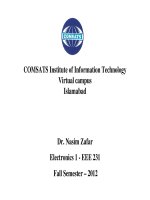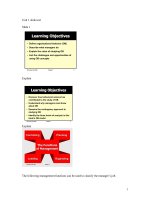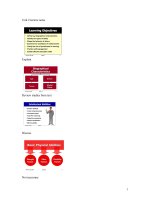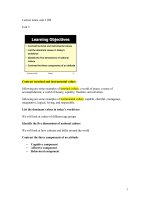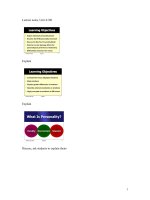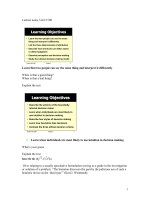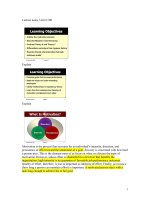Organizational behavior: Lecture 32 - Dr. Mukhtar Ahmed
Bạn đang xem bản rút gọn của tài liệu. Xem và tải ngay bản đầy đủ của tài liệu tại đây (358.82 KB, 50 trang )
Organizational
Behavior
(MGT-502)
Lecture-32
Summary
of
Lecture-31
Elements of
Organizational Structure
Departmentalization
Span of
Control
Organizational
Structure
Elements
Formalization
Centralization
Common
Organizational Design
• Simple Structure
• Bureaucracy
• Matrix Structure
The Distinguishing
Feature of Job Design in
the Future
Evolving Forms of
Organizational Design
• Several new forms of organizational
design
–Self-managing teams
–Team-based approach
–The virtual organization
Today’s Topics
Four Symptoms of Structural
Weakness
• Delay in decision
making
Overloaded hierarchy; information
funneling limited to too few channels
• Poor quality
decision making
• Lack of innovative
response to changing
environment
• High level of
conflict
Right information not reaching
right people in right format
No coordinating effort
Departments work against each
other, not for organizational goals
Organizational Strategy
Mission
What we are or want to be?
Specific Goals
What must be achieved? When?
Strategy
What will we do to get there?
Environmental Factors
• Environmental Uncertainty
– Exists when managers have little information
about environmental events and their impact
on the organization.
– When the organizational environment is
complex and dynamic, the manager may have
little information about future events and have
great difficulty predicting them.
Environmental Factors
• Environmental Complexity
– The number of environmental components
that effects on organizational decision making.
• Environmental Dynamism
– The degree to which these components
change.
Elements of the Environment
Technology
Political/Legal
The Organization
Sociocultural
Economic
Org. Environment & Structure
Dynamic
• High rate of change
• Use organic structure
Complex
• Many elements (such as
stakeholders)
• Decentralize
Stable
• Steady conditions,
predictable change
• Use mechanistic structure
Simple
• Few environmental
elements
• Less need to decentralize
Org. Environment & Structure
(con’t)
Diverse
• Variety of products,
clients, locations
• Divisional form aligned
with the diversity
Hostile
• Competition and resource
scarcity
• Use organic structure for
responsiveness
Integrated
• Single product, client,
location
• Don’t need divisional form
Munificent
• Plenty of resources and
product demand
• Less need for organic
structure
Technology
• The Electronic Revolution - Webbased and other technologies have
allowed companies to take a new look
at their structures.
• The trend is to use more organic
forms that support flexibility.
Technology
Early focus - Production processes
Later focus - Knowledge technology
–Task Variability
–Problem Analyzability
Work Design and
Technology
Technology in the Workplace
• Continuous Improvement Processes
– Good isn’t good enough
– Focus is on constantly reducing the variability in
the organizational processes to produce more
uniform products and services.
• Lowers costs and raises quality.
• Increases customer satisfaction.
– Organizational impact
• Additional stress on employees to constantly excel.
• Requires constant change in organization.
Key Elements:
• Identifying an organization’s
distinctive competencies.
• Assessing core processes.
• Reorganizing processes.
Process Reengineering
Rethinking and redesigning the
processes by which the
organization creates value and
does work, ridding itself of
operations that have become
antiquated.
Downsizing and Rightsizing
• Downsizing (rightsizing) involves
reducing the size of the organization by
selling off or closing down units or
product lines to increase profitability.
• Probably will call for a change in
structure.
Mergers and Acquisitions
• The search for competitiveness may call
for the joining of two or more firms through
M & A.
• The challenge for these firms is to find a
structure that works for the combined
entity.
Learning Organization
• Learning
Organization
proactively creates,
acquires, and
transfers
knowledge
throughout the
organization
What’s an e-Organization?
A profit or nonprofit organization
that uses the Internet and
private network links to facilitate
activities and communication
Electronic Commerce
